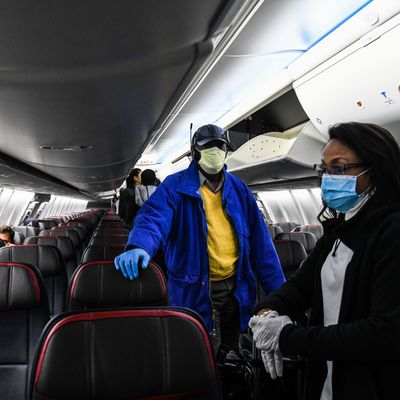
JetBlue, headquartered in Queens, calls itself “New York’s Hometown Airline.” Of all the U.S. passenger air carriers, its route network is the most focused on service to and from the New York City market. So, with the New York region bearing the brunt of the coronavirus crisis, I’m not surprised JetBlue is the first large U.S. passenger carrier to announce a policy that not just staff but passengers must wear masks in flight, starting May 4.
“Wearing a face covering isn’t about protecting yourself; it’s about protecting those around you,” says Joanna Geraghty, the airline’s President and COO. That formulation is correct and I also think helps explain why airlines have been slow to make this shift.
Because masks are more about protecting others than protecting themselves, the primary reason for an apparently-healthy person to wear a mask is not fear, but solidarity or altruism. And those motivations only go so far. On the ground, compliance with government orders to wear masks has been mixed. I’m not surprised that airlines would worry that a compulsory mask rule would alienate customers who don’t want to wear one for hours at a time, or would lead to confrontations with customers who refuse to obey a mask requirement. Flight attendants’ unions, which have advocated mask requirements, share this last concern; as such, Sara Nelson, the president of the Association of Flight Attendants, has urged airlines to communicate their mask policies to passengers clearly in advance of imposition, as JetBlue has done.
The issue of masks on planes is similar to the issue of smoking on planes. The vast majority of American adults do not smoke, and even back in the 1980s when smoking rates were higher, less than half the adult public were smokers. And what non-smoker wants to sit next to someone who’s smoking on a cramped airplane? Yet, the majority did not rule on smoking when the issue was left to the market: Airlines generally permitted smoking until the government prohibited it, first on domestic flights under two hours in 1988 and then on virtually all domestic flights in 1990. The fact that the market inflicted the minority’s smoking on the non-smoking majority reflected a difference in intensity of consumer preference: Smokers apparently cared more about being allowed to smoke than non-smokers cared about being seated on a plane with smokers.
But there’s a key difference between smoking and the coronavirus: Being around smokers on a plane may increase my risk of lung cancer, but I don’t get off a smoking flight and spread cigarette smoke to the people I meet for the next several days. Coronavirus spreading on an airplane isn’t just a hazard to the customers and workers on the airplane, it’s a public health hazard to people those people may encounter after they get off. So I would amend Geraghty’s comment: The mask isn’t to protect you, it’s to protect the people around you, and the people they will be around in the future. This is why JetBlue is right to require masks during the acute phase of this crisis and the other carriers should follow; if they don’t, the government should make them, since the policies have effects on people who are not customers or employees of the airlines.





























